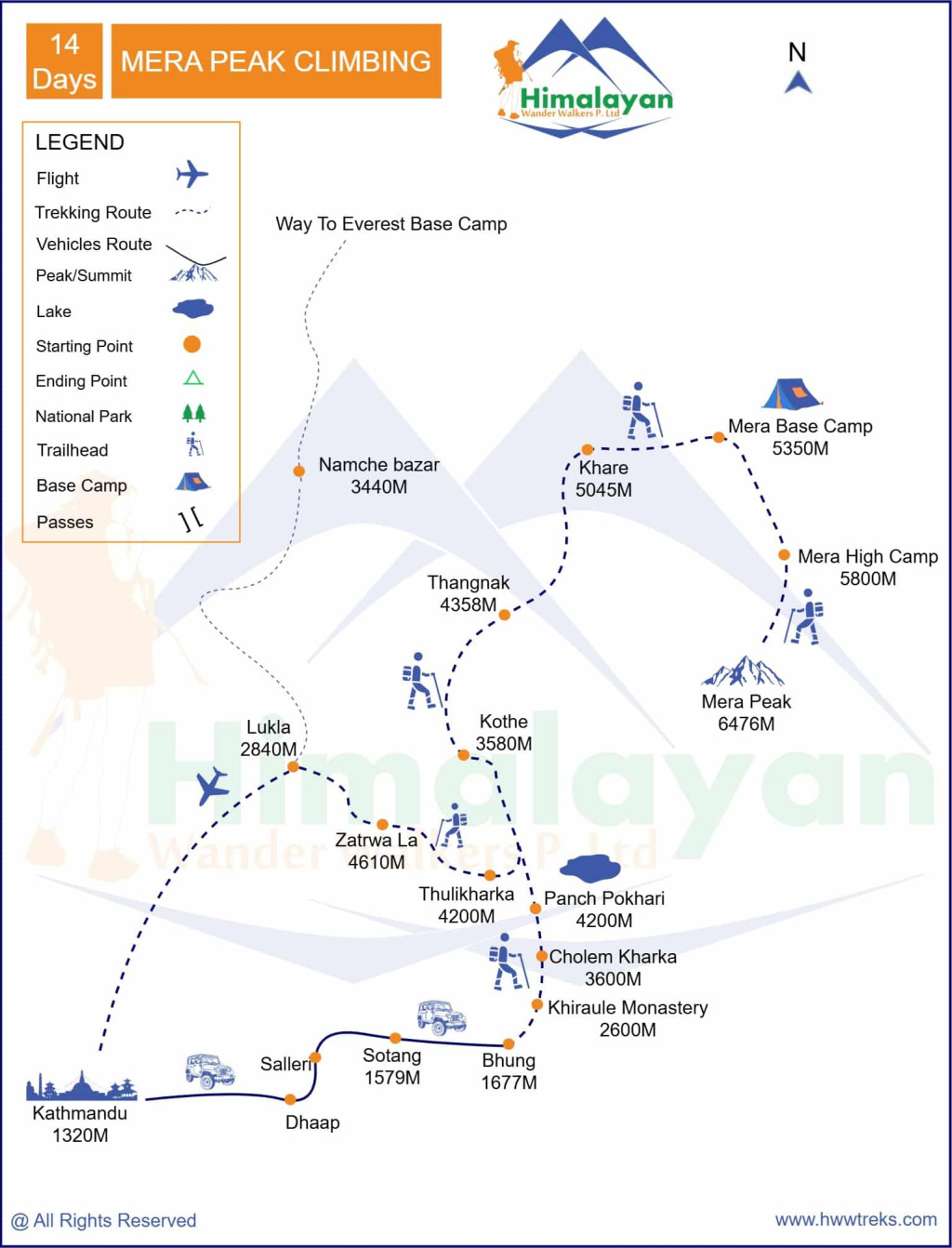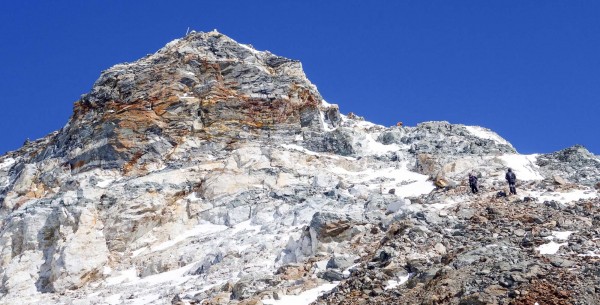Important Information
Region
Peak climbing and Expedition
Duration
14 Days
Max Altitude 6476 meters
Best Season March, April, May and September, October, November
Grade
Level 3
Group Size
2 - 5 people
Transportation 2 way Flight
Mera Peak Climbing is the highest trekking peak among all trekking peaks in Nepal with a height of 6,476 meters. Mera Peak is hidden in the upper Hinku Valley of Makalu Barun National Park. Mera Peak doesn't need much technical knowledge as it can be climbed by novice climbers and mountaineers. Jimmy Roberts and Sen Tenzin summited Mera Peak for the first time on May 20th, 1953. The best seasons for climbing Mera Peak are from March to May and September to December.
What do you expect from Mera Peak?
The summit of Mera Peak is one of the best skylines, offering jaw-dropping panoramic views of popular mountains of the Khumbu region and beyond namely Massif Mountains like Everest, Kangtega, Nuptse, Lhotse, and other renowned trekking peaks of Nepal. All the climbers will trek for a couple of days before summiting Mera Peak for acclimatization and a successful summit trip. Trekkers will first trek through the lush woods with the beautiful rhododendrons and yak pasture experiencing the dramatic landscape of Hinku valley. The locals, the Sherpa people will welcome you with their warm hospitality.
Himalayan Wander Walkers’ veteran expedition Sherpa will help you to stand on top of Mera Peak with our teamwork for your Mera Peak summit journey. We believe that our guests deserve great value and we make things happen in the outdoor industry. Himalayan Wander Walkers provides a variety of itineraries for Mera Peak climbing. So, for more information please mail us at hwwtreks@gmail.com or info@hwwtreks.com.
If you are looking for a different itinerary than the one here, please Customize Your Trip.
Highlights of the Mera Peak Climbing
- Summit One of the amazing Peak of (Nepal’s highest trekking peak 6476m)
- Immerse in the hospitality of Sherpa people
- Explore the jaw-dropping views of the highest mountains from the skyline level
- Experience the Mountain Expedition life of Sherpa
- Diversity of geographical structure within a single journey
Include
Airport Pickup and drop international and domestic
Pasang Lhamu Rural municipality entrance
Mera Peak climbing permit
Trekking Guide & porter
Climbing guide
All Meals (Breakfast, Lunch & Dinner) during a whole trek
One-way flight (Ktm-Luk or Ramechap to Lukla)
All climbing gears
2 Nights Accommodation in Kathmandu
Two-night Camping equipment and staff
Exclude
Travel rescue, insurance,
Tips for Guide,
International tickets,
Nepali visa fee
Bar bills, Repair charge for any physical damage on motorbikes, Personal Expenses etc
Others not mentioned in Includes section
Route Map

Important Information
Peak climbing is a second step after the normal trekking who wants to experience the adventure beyond the trekking. There are more than 1300 peak with 6000 meters among which only one quarter of them are officially opened for climbing Nepal government.
Apart from mountaineering expedition, we also offer numbers of trekking peaks with altitude ranging between 5000m to 6600 for well-experienced trekkers and beginner climbers. It obvious that all kind of climbing need technical skill and experience guide which Himalayan Wander Walkers provides you. Peak climbing in Nepal offers the best adventure trekking and expedition experience to all kinds of Himalayan Wander Walkers is a specialized in organizing climbing training course at base camp before the summit start.
CHECKLISTS FOR MERA PEAK CLIMBING
- Valid passport (valid for six months from the date of your trip)
- MasterCard, Visa Credit, and Debit Cards are accepted in Nepal. However, some cash is highly recommended.
- Mobile (if your cell phone is from CINGULAR USA or ATNT (USA) operators, then your cell phone will work in Nepal.)
- Clothing (Layered clothes, windproof and waterproof jackets, fleece pullovers, thermal base layers, hiking pants, shorts, headwear, footwear, and other items according to your needs)
- Personal Items and Toiletries (First-Aid Kit, Iodine tablets or a UV purifier to treat water, Sun Protection)
- Travel and Health Insurance
- Trekking gear and equipment(if you have your own trekking gear and equipment, such as trekking poles, sleeping bag, and shoes, then you can bring them; else you can rent them in Thamel, Kathmandu). Read more for trekking gears and peak climbing gears.
Guiding, Food, and Camping
In Nepal, all trekking supplies - camping equipment, kitchen implements, food - are all carried by pack animals like mules, Yaks, and horses. Even Porters are common in Nepal. All trekkers are accompanied by a guide, a cook, and usually at least one horseman or yak herder. With the surest footing; they lead trekking groups across the passes. The horseman and cook will usually run ahead during a trekking day. They will have prepared a packed lunch for hikers and will go on to the night’s resting place to set up camp. They set up tents, cook dinner, and ready the area for arriving trekkers. When trekkers reach the campsite they are greeted with a hot cup of tea and biscuits in the dining tent. After six hours in the mountains, no drink will ever taste sweeter. For dinner, the cook will usually prepare a buffet of dishes that are as welcome as they are delicious.
Note regarding itineraries.
Although we generally adhere to the schedule, the itinerary is subject to change for numerous reasons beyond our control, including weather and terrain conditions, suitable campsite availability, and the group's general fitness level. It is important to understand that our trek is logistically complex and it is not unusual that adjustments be made. Our guide will orient you each evening to the following day's plan; their good judgment is the key to the long history of successful treks that Himalayan Wander Walkers has led till now. Please remember that our ability to make adjustments as needed helps to ensure that your trek is successful.
Frequently Asked Question
Yes, you can customize this package to fit your schedule and preferences. Whether you want to modify the trek's length, add rest days, or add side treks along the route, we'll collaborate with you to tailor the experience to your liking. Just let us know what you're looking for, and we'll make the necessary adjustments: "Customize Your Journey."
Mera Peak is located in the Hinku Valley of the Khumbu region in Nepal near Makalu Barun National Park. The peak offers spectacular views of Everest, Kangchenjunga, Lhotse, Cho Oyu, and Makalu, making it one of the most scenic climbing destinations in Nepal.
Mera Peak stands at 6,476 meters (21,247 feet) above sea level, making it the highest trekking peak in Nepal. The peak has three summits - Mera North at 6,476m, Mera Central at 6,461m, and Mera South at 6,065m. Most climbers attempt Mera North, which offers panoramic views of five 8,000-meter peaks including Everest, Lhotse, Cho Oyu, Makalu, and Kangchenjunga.
Yes, an experienced climbing guide is highly recommended and often mandatory. Nepal's regulations require certified guides for most trekking peaks for safety and legal compliance. Guides provide route finding, glacier travel instruction, safety management, emergency response, and handle permits.
The best seasons for Mera Peak climbing are spring (March to May) and autumn (September to November). Spring offers stable weather and warmer temperatures but can be crowded and has higher permit costs. Autumn provides crystal-clear mountain views and stable conditions with lower permit costs. Winter is extremely cold and challenging, while monsoon season (June to August) brings heavy snow and poor visibility, making climbing unsuitable.
Mera Peak climbing costs about $2,300.00 (All-inclusive price) per person. However, the total cost depends on several factors including season (peak season costs more than off-season), service level, transportation (flight or land transport), guide and porter ratio, and many more. Contact us for a customized quote based on your specific preferences and travel dates.
You should be capable of hiking 6-8 hours daily for consecutive days at high altitude while carrying a backpack. Prior high-altitude trekking experience is recommended. Train with cardiovascular exercises for 4-6 months beforehand, including strength training and practice with mountaineering equipment like crampons and ice axes.
Start physical preparation 4-6 months early with cardiovascular training, strength exercises, and weighted backpack hiking. Practice with mountaineering equipment especially crampons, ice axes, and rope techniques. Mental preparation includes route research, developing coping strategies for challenging conditions, and managing expectations about the remote and demanding nature of the climb.
Altitude sickness is common above 2,500 meters and since Mera Peak reaches 6,476 meters, you may experience symptoms including headaches, nausea, and fatigue. Prevention requires proper acclimatization with gradual ascent and rest days. Stay hydrated, avoid alcohol, and follow the "climb high, sleep low" principle. Most itineraries include acclimatization days in Khare and other strategic locations.
Yes, comprehensive travel insurance is essential for Mera Peak climbing. Your policy must cover high-altitude mountaineering activities up to 6,500 meters and include emergency helicopter rescue and medical treatment coverage. The insurance protects against altitude sickness and medical emergencies. Most trekking agencies require proof of insurance before booking.
During the initial trekking days, accommodation includes basic tea houses with shared rooms and simple local food options. In the higher sections and at Base Camp, accommodation is in tents with provided sleeping gear. Food includes dal bhat, noodles, soups, and energy-rich meals, though options become more limited at higher altitudes.
For the Mera peak climbing, essential gear includes mountaineering boots, crampons, a harness, a helmet, an ice axe, a down jacket, waterproof layers, warm gloves, glacier glasses, and a 4-season sleeping bag. Technical equipment like ropes and climbing hardware, is typically provided by climbing companies. Many items can be rented in Kathmandu. Read more about peak climbing gear and equipment.
No questions found matching your search. Try different keywords or browse all questions above.
| {{type.min}} - {{type.max}} Pax {{type.name}} - {{type.desc}} | {{type.display_price}} per people |
Extra prices:
Let us help you decide Inquiry
You might also like

- 15 days
- Peak climbing and Expedition
Island Peak Climbing
Imja Tse, Island Peak (6160m) is the best trekking peak in the Everest region for novice climbers to develop the skills of climbing on snow and ice at high altitudes.Island Peak is the number one rating climbing peak in the Everest Region of Nepal which has (6,189m/20,305ft) heights. It is also known...



